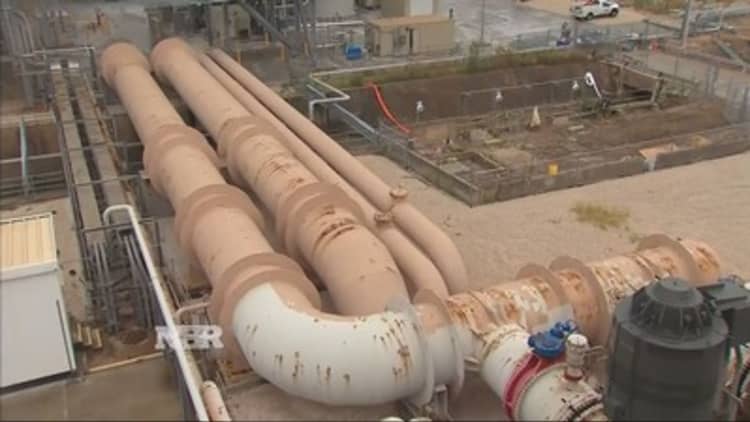With energy commodities falling and demand from China and elsewhere showing signs of weakness, investors may be excused for thinking there's no growth left in energy for now. But they may be wrong.

The U.S. onshore drilling boom has unleashed a tidal wave of natural gas. From 2005 through 2014, U.S. dry natural gas production surged more than 40 percent, according to the Energy Information Administration. It's a big reason the commodity is so cheap—futures are priced at under $3 per million British thermal units, and the number of U.S. gas rigs has fallen by a third since last year, according to Baker Hughes.
But one part of the U.S. gas market is thriving: infrastructure. Several companies are plowing billions into new projects, making long-term bets that demand for nat gas will grow and, along with it, the need for infrastructure to transport, store and process it.
"This is more of a response to the oversupplied market," said John Hilfiker, an analyst at Bentek Energy, the market analytics unit of Platts. "The past two to three years, you've been in a situation where producers couldn't grow production because there wasn't enough pipeline to handle it."
Read MoreNow that oil has cracked $50, here's its next stop
Bentek Energy estimates that roughly $54 billion has been invested in new natural gas pipeline capacity in the United States since 2009. Nearly double that—another $104 billion—is planned between 2016 and 2018.
Unlike crude oil, which can be moved by pipeline, train, barge or tanker, the transportation of natural gas is extremely limited. Gas can be compressed or liquefied and then carted by truck, but pipeline is the only way to move significant quantities.
Analysts say a lack of domestic infrastructure—pipelines can take years to get approved and built—has actually weighed on production growth. And even if gas production falls further amid prolonged low prices, a transportation shortage still exists. That's the reason some producers, most notably in North Dakota's Bakken formation, have been "flaring" gas—the practice of burning off excess that can't find a place in pipelines.
The lion's share of current investment is in the Northeast, home to the Utica and Marcellus shale formations, two of the country's biggest natural gas plays. Their combined output accounts for roughly 27 percent of all U.S. gas production, according to Bentek, up from just 9 percent in 2011. The EIA forecasts that the Marcellus and the Utica will continue to drive production.
"The Utica and Marcellus shale are the hot spots in the gas market, … and a number of new pipeline projects are planned from there over next four to five years," said Luke Jackson, a project consultant for Bentek Energy.
"The Northeast has seen a lot of infrastructure constraints," added Peggy Connerty, an analyst covering master limited partnerships at Morningstar. "The past few winters, we saw price spikes because there wasn't the infrastructure to get gas to power plants."
IHS, which tracks energy markets, recently said the Marcellus Shale region can expect to see 17 new pipeline projects over the next three years.
Read MoreNatural gas now tops coal as top source of US electricity
What's perhaps most interesting is where the demand is coming from. End users including power plants that have been converting from coal-fired generation are seeking more gas, many of them located in the Southeast or the Midwest.
A shift in gas flows really came into focus last year, when the Rockies Express Pipeline, which was built to move gas from Colorado and Wyoming to Ohio in 2009, was reversed to bring gas from the Appalachian Basin to Midwest markets. The 1,712-mile-long pipeline is joint venture of subsidiaries of Tallgrass Energy, Phillips 66 and Sempra Energy.
By year's end, pipeline expansions by midstream energy giants Kinder Morgan, Spectra Energy and Williams Cos. will come online to carry gas from Marcellus to Southern and Midwestern states as well. Kinder Morgan also recently said it will buy the 49 percent stake it doesn't already own of Elba Liquefaction, a natural gas joint venture with Royal Dutch Shell.
Demand for gas transportation to the Gulf Coast is also rising—marking another major reversal. As projects focused on Liquefied Natural Gas exports get underway, like Cheniere Energy's expanding Sabine Pass LNG terminal, and companies build petrochemical complexes, like Sasol's $8 billion ethane cracker, more pipelines will carry gas to the area.
Morningstar's Connerty noted that the shares of many midstream master limited partnerships, which build, own and operate pipelines and other infrastructure-related assets, have declined in recent weeks as investors react to the possibility of higher interest rates out of the Federal Reserve. But she noted, "Even with a higher rate environment, there's still a lot of growth left, because a lot of infrastructure needs to be built."
It's also the reason some of the largest recent acquisitions in the energy industry have been tied to natural gas. Last week, Marathon Petroleum's master limited partnership, MPLX, announced that it's acquiring MarkWest Energy Partners for $15.6 billion. MarkWest operates in the Marcellus and Utica, processing and transporting nat gas.
Read MoreOil field paychecks: They're still big, but not booming
And earlier this month, Williams Cos received a takeover bid from Energy Transfer Equity. Earlier this year, Williams announced its own plans to absorb its subsidiary Williams Partners in a $13.8 billion deal. Energy Transfer, which itself owns more than 70,000 miles of oil, fuel and gas pipelines, has reportedly said it will pursue Williams Cos whether the company cooperates or not.
"We expect to see more of M&A activity here. … Consolidation was slow to take off, and we expect to see more of that now that pricing is starting to stabilize," said Connerty.
In terms of stocks focused on nat gas infrastructure, Connerty likes Enterprise Products Partners, a master limited partnership with more exposure to natural gas liquids, but one that has "great assets" including pipelines.


